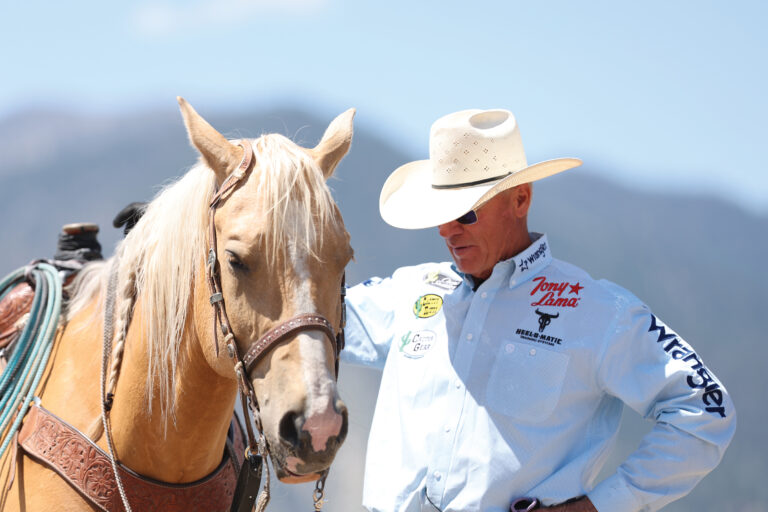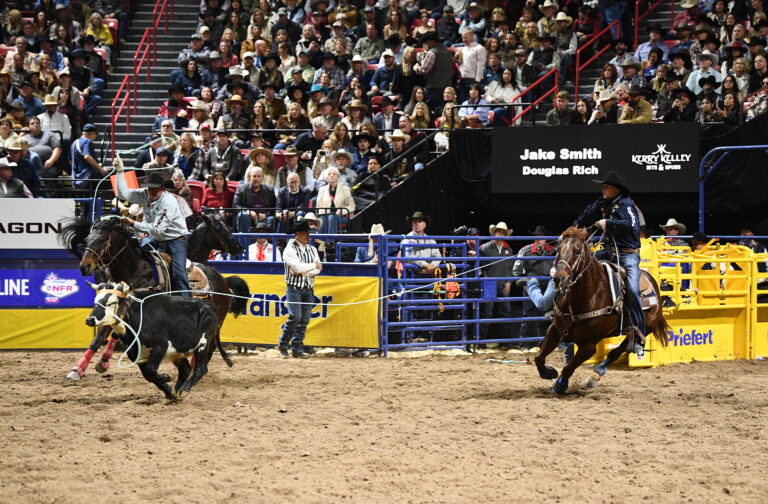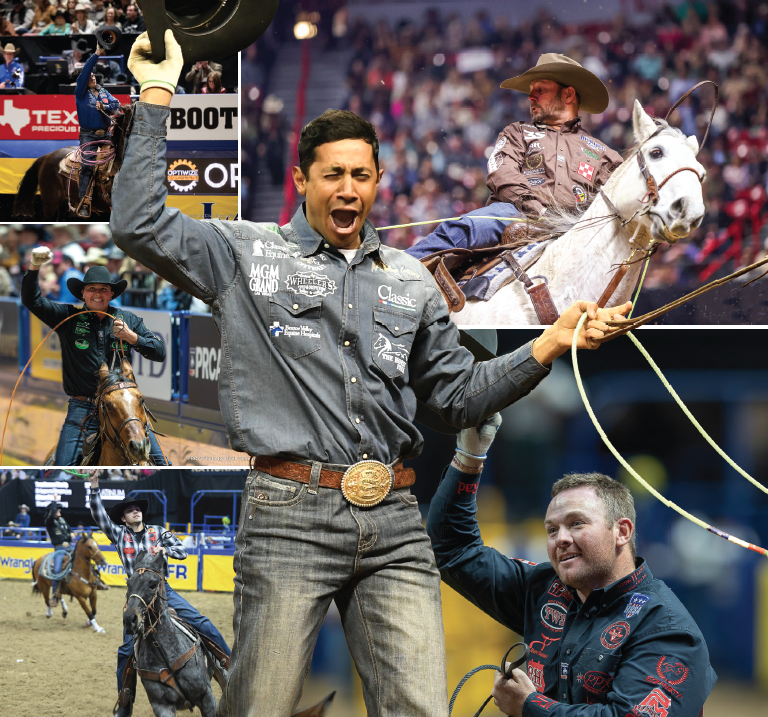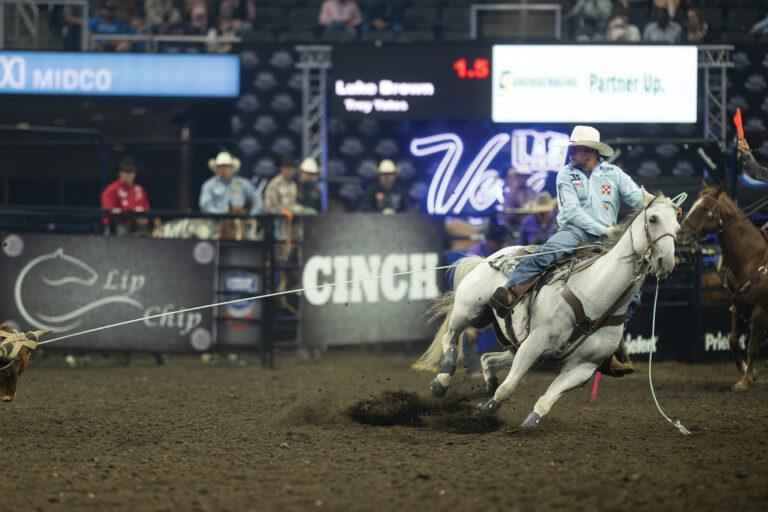What makes the ideal horse for a lower-numbered header?
On the most basic level, the job of a head horse is fundamentally the same no matter who is in the saddle: score, rate, take hold of the steer, move off the corner and face. But are there certain traits that can make that horse a better fit for lower-numbered headers?
Ask those ropers themselves or the folks who teach and you’ll get a resounding yes.
For experts Ryan Motes and Travis Woodard—both horse trainers, clinicians and veterans of the Wrangler National Finals Rodeo—there are just two key things to look for when in the market to buy: gentle and seasoned.
For more traits to consider, lower-numbered ropers Frank McCarthy and Liz Hirdes threw their preferences into the conversation with Motes and Woodard to make our top 10.
WATCH: Ryan Motes’ Bit Masterclass on Roping.com
1) Calm Disposition
Or as Ryan Motes puts it, “Gentle. Period.”
This is the most critical trait in both Motes’ and Woodard’s opinion.
“Most of your lower-numbered ropers are businessmen or people with full-time jobs who can’t ride all the time,” Woodard noted. “They need a horse they can throw their wife or kids on for a trail ride if they want.”
A calm and forgiving horse allows those folks to spend more of their limited time roping and less time trying to ride the edge off a fresh horse.
Safety should be of paramount importance, and having a gentle horse goes a long way to keeping ropers, and those around them, from getting into jams.

2) Experienced/Well-Patterned
“You want a horse that has been there and seen everything,” Motes said. “A horse that will only focus on roping. Don’t sacrifice experience for anything.”
Because lower-numbered ropers are often beginners, it’s important that the roper is not having to think about his horse’s position in a run and is able to concentrate on his swing and delivery.
Like having a gentle disposition, a seasoned horse is going to be safer for the roper, particularly as a header.
“The box is probably the easiest place to get hurt in team roping and it’s real easy for head horses to get nervous,” Woodard said. “It’s of paramount importance, if you’re going to buy, that a horse be solid in the box.”
“You definitely want a horse that scores good and is calm in the box,” McCarthy, 65, added.
A former fire captain with the Los Angeles County Fire Department, McCarthy had ridden and roped since he was a kid but was returning to the sport after retirement. “As a low-numbered roper, you’re already nervous enough in the box, you don’t need a horse that gets that way, too.”
A solid pattern is especially evident during the run, when a horse is called upon to rate the steer.
“The ability of that horse to get to position and stay there for a series of swings for beginners or even intermediate ropers is so important,” Woodard said. “If the horse is wildly on the gain or cheating off too far back, that makes a more difficult shot for the roper.
“The horse needs to match the speed of the steer smoothly and consistently particularly as ropers are learning to go from roping the dummy to roping off the horse,” he said. “If you think about it, when you’re roping the dummy, you’re both going the same speed, zero miles per hour. So you need the horse to recreate that for you.”
READ: Rope Horse Futurities and Lower-Numbered Ropers
3) Honest
A sister trait to seasoned is honest—a horse that not only knows his job but does it every time.
“A lot of these guys work and only get to rope maybe once or twice a week,” Motes noted. “They rope as a hobby.”
As a result, their horses tend to spend time in the pasture or pen most of the week before getting pulled out for a little practice Friday and off to the jackpot on Saturday. The roper will be looking to work on his own skills, not spending time tuning on his horse.
“The horse has to be honest, not ducking off on the corner or cheating when he’s trying to throw,” Woodard said.
4) Older (Like Fine Wine)
While the sexier thing to do is have a young horse that, in theory, will last a long time, Motes says looking at middle-aged horses is a better bet.
“You want those 12-, 14-, even 16-year olds that don’t require a lot of riding. In fact, it’s better for them if you don’t,” Motes said.
He said a good compromise solution lately has been when ropers buy a futurity-aged horse but leave it in the hands of the trainer to season out.
“That works out better.”
Woodard agreed.
“A lot of times, you’ve got these guys who have been successful and they want the Ferrari or Lamborghini of rope horses, a 6-year-old with all the breeding,” he said. “But the truth is, they can’t ride them because it takes maintenance to keep those horses working.”
McCarthy admits he fell into the trap of wanting a horse that was more than he needed.
“When I went to purchase a horse, I said I wanted a Driftwood that was fast, and I don’t want him to kill me,” McCarthy joked. Thankfully, he found help in Motes and fellow Wrangler NFR roper Brock Hanson in lining the horse out for his skill level.
“I’m one of the luckiest guys out there,” he said, noting that both pros helped him and his horse improve their skills together and he still gets the opportunity to rope with them frequently. “They’ve helped me from catching to consistency and good handles . . . forcing me to do things right because, if I don’t, I’m not helping them train their horses.”
READ: Do Not Disrespect Older Horses
5) Maintainably Sound
Completely sound often doesn’t come with an older, seasoned horse. But that’s OK, according to Motes.
“Soundish works, as long as you can maintain it,” Motes said.
6) The Goldilocks Level of Thinking
While it may seem counter-intuitive, a horse that is patterned also needs to be broke and adaptable enough to not get ahead of the roper.
“I don’t want a horse that is thinking for you and may start to duck out on the corner before you’re ready,” McCarthy noted.
In short, the horse needs to know where he’s supposed to be but not try to get there ahead of the roper. He’s thinking, but he’s also waiting.
7) Natural Ability
Liz Hirdes married into a well-known roping family in California that raises and trains a lot of horses. She herself is a talented breakaway roper and team roper, but she is also a working mom with limited time for practice.
For Hirdes, a horse’s athleticism is critical. Though she ropes in all divisions, she wants a horse who can handle itself in any situation.
“He needs to know where his feet are and be broke enough to stay in my hand,” she said.
Woodard notes that the horse must be strong enough to pull the steer and provide a good handle, but that speed is not as important as it once was.
“With the World Series barrier being so short, speed isn’t everything. You don’t need A-plus speed; you can get away with B-minus speed.”
Once you’ve dallied, the horse needs the natural ability to provide a good handle for the heeler.
“He can’t be weak, but he also can’t be out of control; pulling too fast is a great way to make your heeler miss, no matter what level he is,” Woodard said.

8) Adaptable
Along with that athleticism, Hirdes is looking for an adaptable horse because she ropes with different levels of heelers.
“If I’m roping in a #13 roping with an 8 or 9 heeler, I want him stronger off the corner, quicker-footed in that situation,” Hirdes said. “But in the lower-numbered ropings and all-girl ropings, the cattle aren’t the lighter, fresher ones; they tend to be older and bigger. They’ve got head tricks and they drag.”
Lower-numbered headers need to be able to put their horses in a spot to pull the steer for their lower-numbered heelers, Hirdes added.
“A horse you can manipulate in the run helps a lot with handling cattle to suit your level of heeler,” she said.
The rise of roping futurities has shown the value of this, as well, as Hirdes points out.
“The awesome, stand-out horses at those deals are shown by the trainer in the open, and then the owner can get on and show the horse in the novice or non-pro division,” she said. “That’s the versatility of an adaptable, broke horse. He can run and score but, also, he can read the situation.”
9) Good Manners
Outside of the performance-based traits, Woodard noted that the horse’s manners matter, too.
“Is he easy to load? Can he handle the travel? Is he good for the shoer?” Woodard asked. “Those are the things that just make life easier.”
“When you’re not doing this for a living, these horses become like part of the family, and you want to enjoy your horse.”
WATCH: Behavior Expectations on the Ground
10) The Gingerbread
While things like looks or the popular names on the papers certainly can add to the pride of ownership, both Woodard and Motes caution against weighing those factors ahead of performance-based features.
“You can pay for the King Ranch edition or a standard work truck,” Motes said. “They do the same job, but one is more expensive, so don’t get caught up in the papers.”
“I’m a function over fashion guy myself,” Woodard said. “You can have a gorgeous horse, but if you can’t ride one side of him, he does you no good.” TRJ









